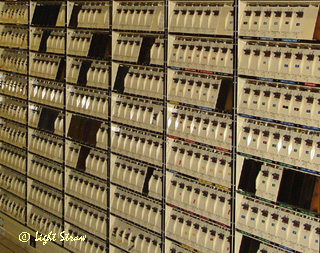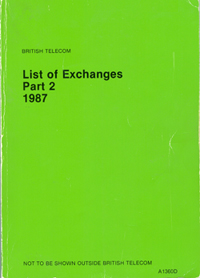 |
Once, all switching equipment used electro-mechanical switches to connect telephone calls. The Strowger system used a step-by-step process to route calls through the exchange. The Crossbar system used cross-point switches with marker control and lots of relays. Even the replacement electronic systems used reed-relays, until the solid-state System X and System Y switches were introduced in the late 1970s. |
Automatic Telephone Exchanges (ATEs) are (or used to be) categorised into two kinds:
|
Director
Director Exchanges grew from the requirement for an automatic switch that could route calls between a large number of exchanges that were located within in a small area (e.g within a city such as London).
The original Director areas had dialling codes beginning:
|
Learn more about Director Exchanges.
Non-Director
All other exchanges and codes are assumed to be Non-Director. This type of switching can be found in the smallest exchange of just a few hundred (or fewer) subscribers and was used in large towns as well.
Telephone eXchange (Types)
The different exchange types can then be split according to size and type of switching equipment in use:
| TXS | Telephone eXchange Strowger |
| TXK | Telephone eXchange Crossbar [Exceptionally the C is changed to a K] |
| TXE | Telephone eXchange Electronic |
| TXD | Telephone eXchange Diigital |
TXS or Strowger exchanges, were electro-mechanical and known as step-by-step, as the switching stages followed a pre-wired start to finish path through the equipment.
 |
Throughout the Strowger era there have predominantly been only three different versions of the 2-motion selector, some older exchanges using a mixture of all three, which were: |
 |
The first Telephone eXchange Crossbar no.1 TXC1 to be installed by the Post Office was in Broughton, Lancashire in 1964. TXC sounded too much like TXE, so the designation was later changed to TXK. |
 |
One of the first model electronic exchanges opened in Dollis Hill in 1959, followed by an 800 line unit at Highgate Wood, London in 1962. Both used TDM (Time Division Multiplexing) and PAM (Pulse Amplitude Modulation) systems. However, as integrated circuits and microprocessors had not yet been developed, the costs were too high and therefore SD (Space Division) techniques using reed relays were chosen. |
 |
The first exchange to switch Pulse Code Modulation (PCM) signals from one group of lines to another, in digital form, was demonstrated at the Post Office Research Station on 15th February 1968. |
 |
Inter-exchange signalling on the junction, trunk and international networks has evolved over the years from simple digital techniques on copper cables, through analogue to high speed data and voice capability at ever more flexible bandwidths over fibre. |
Here is a list (circa 1980) of the letter designations of all the main types of exchanges in use at the time:
| D | Director, Strowger |
| DE | Director, Electronic |
| DK | Director, Crossbar |
| DY | Director, mixed Strowger & Electronic |
| DZ | Director, mixed Strowger & Crossbar |
| ND | Non-Director, Strowger |
| NDE | Non-Director, Electronic |
| NDY | Non-Director, mixed Strowger & Electronic |
| NDZ | Non-Director, mixed Strowger & Crossbar |
| U | Unit Automatic Exchange, Strowger |
| LC | Line connector with an exchange name |
| IAX | Island Automatic Exchange |
| SAX | Small Automatic Exchange, Strowger |
| (M) | Mobile Exchange |
| DDI | Exchange codes allocated to PBX groups with Direct Dialling In facilities. |
Over the years, quite a variety of letter codes have been (wrongly?) used, most commonly the D or ND being omitted and the letter X being used for eXchange, to free up the letter E to be used for other abbreviations.
Thus A.T.E. is generally an Automatic Telephone Exchange and an N.D.X. is a Non-Director eXchange.
TXK was used for Crossbar as C and E sound similar.
And the list for A.M.C.s (Auto-Manual Centres ) e.g. Operator Services:
|
| GSC | Dedicated Group Switching Centre |
| SSC | Sector Switching Centre |
| DSC | District Switching Centre |
| D | Director |
| ND | Non-Director |
| E | Electronic |
| K | Crossbar |
| I/C | Incoming |
| O/G | Outgoing |
| RT | Register Translator |
For Telephone Exchanges, the abbreviation is TE, or ATE for Automatic Telephone Exchange, but seldom TX, which usually refers to the equipment rather than the place or the building.
References
 |
 |
 |
The 'Red and Green' books A1360 D Parts 1 and 2 and 'The code Decoder'. |
All logos and trade marks are the property of their respective owners and are used on the Light Straw site(s) for review only. Students and researchers are recommended to make their own independent enquiries as to the accuracy of the information contained therein.